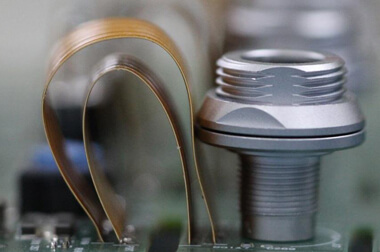1. Flexibility and reliability of flexible circuits
At present, there are four kinds of flexible circuits: single side, double side, multilayer flexible board and rigid flexible board.
(1) Single-sided flexible board is the lowest cost, when the electrical performance requirements are not high PCB.The single-sided flexible board should be used for single – sided wiring.It has a conductive pattern etched by chemical etching, and the conductive pattern layer on the flexible insulating substrate surface is calendered copper foil.The insulating substrate may be polyimide, polyethylene terephthalate, aromatic amide fiber ester, and polyvinyl chloride.
(2) Double-sided flexible board is a conductive pattern made by etching each layer on both sides of the insulating base film. The metalized holes connect the patterns on both sides of the insulating material to form a conductive path to meet the design and use functions of the flexibility. The covering film protects the single and double wires and indicates where components are placed.
(3) Multi-layer flexible board is 3 or more layers of single or double flexible circuit lamination together, through drilling, electroplating to form metallization hole, the formation of a conductive path between different layers. This eliminates the need for complex welding processes. Multilayer circuits have huge functional differences in terms of higher reliability, better thermal conductivity, and easier assembly performance. The mutual influence of assembly size, number of layers and flexibility should be considered when designing the layout.
(4) The traditional rigid flexible board is composed of rigid and flexible substrate with selective layer pressure together.The structure is compact with metallized holes forming conductive connections.If a printed board has components on both sides, rigid flexible board is a good choice.But if all the components are on one side, it would be more economical to use a double-sided flexible board and laminate a layer of FR4 reinforced material on the back.
(5) The flexible circuit of the hybrid structure is a multilayer board, and the conductive layer is composed of different metals. An 8-layer board uses FR-4 as the inner layer medium, using polyimide as the outer layer medium, and the leads are extended from three different directions of the mainboard, each of which is made of a different metal. Constantan, copper, and gold are used as separate leads. This kind of hybrid structure is mostly used in the relationship between electrical signal conversion and heat conversion and the low-temperature condition with relatively strict electrical performance, which is the only feasible solution.
It can be evaluated by the convenience and total cost of the interconnect design to achieve the best performance-price ratio.
2. Economics of flexible circuits
If the circuit design is relatively simple, the total volume is small, and the space is suitable, the traditional internal connection method is mostly much cheaper. Flexible circuits are a good design choice. If the wiring is complex, handles many signals, or has special electrical or mechanical performance requirements. Flexible assembly is the most economical when the size and performance of the application exceed the capabilities of rigid circuits. A 12mil pad with 5mil through-hole and 3mil line and spacing flexible circuit can be made on a single film. Therefore, it is more reliable to mount the chip directly on the film. Because it does not contain a flame retardant that may be a source of ion drilling. These films may be protective and solidify at higher temperatures, resulting in higher vitrification temperatures. Flexible materials save costs compared with rigid materials by eliminating connectors.
High-cost raw materials are the main reason for the high price of flexible circuits. The price of raw materials varies greatly. At the same time, the flexibility of the material makes it difficult to automate the processing during the manufacturing process, leading to a decline in output, defects in the final assembly process include peeling off flexible attachments and lines. fracture. This type of situation is more likely to occur when the design is not suitable for the application. Under the high stress caused by bending or forming, it is often necessary to select a reinforcing material or a reinforcing material. Although the material cost is high and troublesome, the foldable, flexible and multi-layer panel function will reduce the size of the whole assembly, and the material used will be reduced accordingly, thus reducing the total assembly cost.
In general, flexible circuits are indeed more expensive and costly than rigid circuits. In the manufacture of flexible sheets, in many cases, they have to face the fact that many parameters are out of tolerance. The difficulty in making flexible circuits is the flexibility of the material.
3. Cost of flexible circuits
Despite the above-mentioned cost factors, the price of flexible assemblies is declining and becomes close to conventional rigid circuits.The main reason is the introduction of newer materials, improved production processes, and structural changes. The current structure makes the product more thermally stable and there is a very little material mismatch. Some of the newer materials have thinner copper layers that allow for more precise lines, making the components lighter and more suitable for small spaces.
In the next few years, smaller, more complex, and more expensively constructed flexible circuits will require newer method assemblies and the need to add hybrid flexible circuits. The challenge for the flexible circuit industry is to leverage its technological advantages to keep pace with computers, telecommunications, consumer demand and an active market. In addition, flexible circuits will play an important role in lead-free operations.




